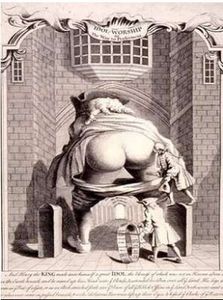Remarks delivered by Virginia Sapiro (Michigan Ph.D. ’76) at the Institute for Social Research/ G.R. Ford School of Public Policy Symposium on Impact on Inequality: Contributions of Michigan Social Science. Panel on Race, Gender, & Empowerment
University of Michigan Bicentennial
Thursday 9 November 2017
I am honored to be invited to participate in this symposium to celebrate the bicentennial of the Catholepistemiad, as this little Detroit institution was known in 1817.
My family has been associated with the University of Michigan for over a century. My grandfather, born and raised on New York’s Lower East Side, the son of eastern European Jewish immigrants, was graduated in 1908 from the Michigan Law School. While a student, he reportedly supported himself by playing the violin in a local vaudeville theater – as far as I can tell, in the then-newly-built Majestic on Maynard St, a couple of blocks from where, just 64 years later, I would fiddle around at the Institute for Social Research for 4 years. My parents met in Ann Arbor, reportedly on the lawn of the Phi Sigma Delta house on Washtenaw Avenue -- he an undergrad, returning after the war, she, pursuing a master’s degree. Fulfilling a prediction apparently made in a photo of 3 month old me in a Michigan sweatshirt, I arrived in Ann Arbor to do a Ph.D. in Political Science in 1972. My son earned an MPP at the Ford School in 2011.
I have chosen to organize my comments around gender, empowerment, and the social sciences. It would be naïve, and terribly 18th-century, to believe that knowledge alone, or even a deep and systematic understanding of the social world alone can lead us to empowerment. But I also believe that only people who have been able to control knowledge, its production, and access can dare be cynical enough to dismiss the critical importance of high quality social science-based knowledge for empowerment.
I will reflect on the history of this field of gender and politics and empowerment by highlighting a few moments in my own writing career during its first decade, when I was still so very clearly growing seeds planted in Ann Arbor. I promise to be selective, and not read you my cv., even for that long ago decade.
Social scientists had so little to teach us about gender and politics when I arrived in graduate school in 1972. We all learned this quickly as we launched our interest in this field by doing what any good student would do to begin: literature review. Many of us wrote and published them in those early days. We found very few studies of women and politics. Most of the comments on women or gender and politics we could glean were little more than stereotype-based side observations or personal interpretations. Most of those observations relied on stereotypes about women’s biology, or personalities, or roles without a shred of evidence or hypothesis testing. Too often, the “observations” were not actually observations – they were untested assumptions. Even those early critical literature reviews were important because without them we had no knowledge, no basis on which to stand or certainly, to take off into the future. Otherwise, in a knowledge world based on stereotype and assumption, most scholars thought the politics of gender was (a) a settled subject and (b) trivial.
So our generation set to work.
The first major research task I set for myself was testing what I thought were previously untested assumptions. We all supposedly knew that women’s political behavior and thinking was shaped by their “special” condition as women – especially that they are mothers, wives, and homemakers. Men’s behavior and thinking was seen as the norm – we didn’t have to explain anything through their special roles. So thanks to the amazing data collected by my graduate mentor, M. Kent Jennings (not to mention his wise move in employing me), I could take the 1965 wave of the Student-Parent Socialization Study with its national sample of high school seniors (just a couple of years older than I was) and the 1973 wave, when they were in their mid-20s, meaning they had branched apart in their life course paths – some getting college education, some marrying, some having children, some entering the workforce.
I studied only the female subsample to look at the impact of the variation in women’s roles, education, and also gender ideology on their political attitudes and behavior. Of course some people said I couldn’t study women’s gender roles and such without studying men. But I wasn’t studying gender differences. I wanted to study the impact of variations in women’s lives and roles to see whether they made a difference. That was my way of turning assumptions about women’s roles into hypotheses and testing them. The answer was – they didn’t make much difference, and what difference they made depended on what we were talking about. In fact, women’s gender ideology made more consistent difference than the roles and life situations themselves in women’s politics. I thought that was pretty intriguing – how we think about and understand gender seemed possibly quite powerful, perhaps even moderating the impact of what we then continued to call gender roles. That discovery now feels so long ago.[1]
Speaking of how we see and understand gender, the informal interdisciplinary training I had at the lunch table at the Institute for Social Research with folks from the Center for Group Dynamics led me to read and learn about intergroup relations, and especially the non-conscious elements of that are part of the functioning of stereotypes. It made sense to me that an important part of how gender operated in politics, especially to keep women out and down, was that gender stereotypes made men, and perhaps women, see men and women and their characteristics and competencies differently in ways they may not even be aware of. I was certainly ready to believe (perhaps from personal experience) that people could hold and act on biases of which they were blissfully unaware. But how could one rigorously test for the effects of a non-conscious bias?
I was impressed with a recent study by the social psychologist Philip Goldberg, in which students were given pieces of writing to evaluate, and told that the author’s name was either John McKay or Joan McKay.[2] It looked like students evaluated John’s work as better. This can’t tell you at the individual level how biased people are, but it could tell us something about the existence of bias at a collective level – a good start. At the time there were no adaptations of that study that I knew of, and I decided to try it myself to see whether it would work in the realm of politics. I gave students a brief text I said was part of a campaign speech by a candidate for Congress named Leeds. It was actually a fairly empty speech – because it couldn’t have any partisan cues in it that might mess with any gender perceptions.
So I asked the students a number of questions about the speech. Was it effective? Did they agree with it? Despite the fact that the speech was on a broad economic policy area, how competent did they think Leeds would be at handling issues of crime? Health care? Business? Foreign policy? Education? Honesty and integrity in government? War and defense? Etc. The trick, of course, was that the students randomly evaluated a candidate named John or Joan Leeds. I was not surprised to find that John would be more competent at issues involving crime, business, and defense, for example, and Joan would be better at health care, education, family issues, and honesty and integrity in government. And people judged John more likely to win.[3] Think of it this way, in those early days, many of us began to study a thing that we thought we saw – and certainly experienced, but most of the world around us, especially those in leadership position could not see because, in fact, it is invisible unless you use the lenses of good social science to see it – non-conscious stereotypes that shape perceptions and behavior, including among people who would be shocked to know that that is what they are doing. And we know ever so much more about how that works now.
These questions – how did women’s so-called “special” roles shape their political attitudes and behavior, and how did gender stereotyping and ideology shape people’s attitudes and behavior, especially with respect to women and politics -- were both important, but there were bigger questions yet. There was a huge “so what” question to think about: Why did gender politics matter? What difference did it really make that so few women held leadership positions in politics? The year I left graduate school women were 4.3% of the members of the House of Representatives and 0.0% of the members of the Senate. (They are now 21% of the Senate and 19.3% of the House. Big deal.) Advocates for women’s inclusion argued that women need representation – they needed to be at the table. They needed their interests to be represented, which couldn’t happen if they weren’t in office.
But as I thought about this, and formulated how I would teach about this, it soon became apparent that the question of women and representation, of the representation of women’s interests was much trickier to discuss, analyze, and justify than it seemed at first. In brief, this question of descriptive representation – whether women must represent women -- is very challenging. Because, in brief, women do lead such different lives, under different circumstances, with different resources, that any certainty over what is being represented by women crumbles under analysis. So I probed the question of descriptive representation of women, and studied the circumstances around the world that seemed to encourage or discourage women’s presence in leadership.
My answer, in the end, was rather limp. Whatever problems there were with justifying descriptive representation of women, especially at the one-to-one level, surely a democratic polity in which half the population is systematically excluded from the ranks of decision-makers cannot be very democratic, and must surely have a deficit of representation.[4] At that time the field had not gotten as far as it did much later, to argue that not only did women lead different lives, under different circumstances, with different resources, but that gender itself is differently constituted by different circumstances and cultures, and institutions, and resources. That was to come later.
And yet, it remained clear that even if the core problem of representation of interests was complicated, there is something profoundly wrong with a supposedly democratic society if women could be half the population, but be excluded from representational leadership roles down to the tune of 4%. Or the current 10%, for that matter. Should I be content if there are no women in leadership if I know that someone of my political party, regardless of gender, is more likely to represent my views than someone of my gender from a different political party? How do we understand democracy?
The first decade of playing out the questions that filled my head as our generation created the field of women and politics was exciting. What were the sources of women’s apparent lower levels of ambition to run for political office? How much conflict was there between genders and generations of the status of women, and how did people perceive those gender and generational conflicts? What were the impacts of internalized norms of gender inequality on rationality? How did gender ideology shape citizenship and nationality policies and social welfare policies? It was exhilarating.[5]
In later work, like many of my generation, and certainly the great later generations of scholars, we pushed our knowledge further in ways that opened up new doors, and made a difference in the world of politics and policy. We learned that the ever-growing gender differences in partisanship that opened up in obvious ways as I was leaving graduate school were attributable not to eternal, biological differences between women, or even to “women’s difference,” but to responses by men to the political world around them. We learned that gender differences in public opinion and partisanship were not constants, as though they were caused by “natural differences” between men and women, but were potentials that were stimulated differently in different electoral years depending on the circumstances and how people responded to them because of the conditions of their lives and the political appeals that reached them. We learned that not only were the fluctuating gender differences in political attitudes and behavior not due to the constants of their basis in gender, but that gender itself is not a constant. We learned to understand in greater detail and nuance the ways that social identities and circumstances such as gender, race, and class shape and condition each other, and must be understood together.
It has been quite a ride, these past 40+ years. Starting out in an era in which there were few women in my discipline, and no women’s studies, and little scholarship on gender, I soon found that the nature and climate of one’s academic community makes a big difference for the work on can do. It was the culture of the people I happened to study with at the Institute for Social Research at Michigan, brilliant social scientists, to believe in well-formulated social science research, and to judge by the quality of the data and analysis. Not a single one of my professors in the Center for Political Studies ever questioned, at least to my face, whether my subject was legitimate, and not one dismissed me or my work on the basis of that subject – this is very different from the experience acquaintances at many other institutions experienced. The proof (or I should say confirmation) for them was in the data and analysis. And much as being a graduate student and going on the market not long after the 1974 recession was scary as hell, that was actually pretty empowering.
[1] This was my dissertation that, when all grown up, became The Political Integration of Women: Roles, Socialization, & Politics (University of Illinois Press, 1983).
[2] Goldberg, Philip. “Are women prejudiced against women?” Transaction 1968,
April, 628-630. For a later review of this literature, see Janet Swim, et al. 1989. “John McKay versus John McKay: Do gender stereotypes bias evaluations?” Psychological Bulletin 105 (3): 409-29.
[3] This became “If U.S. Senator Baker were a woman: An experimental study of candidate images." Political Psychology 3 (1981-82): 61-83.
[4] “When are interests interesting? The problem of political representation of women.” American Political Science Review 75 (1981): 701-16.
[5] Respectively, “Private costs of public commitments or public costs of private commitments? Family roles versus political ambition.” American Journal of Political Science 26 (1982):265-79; “News from the front: Inter-sex and intergenerational conflict over the status of women.” Western Political Quarterly 33 (1980): 260-77; “Sex and games: On oppression and rationality." British Journal of Political Science 9 (1979): 318-24; Women, citizenship, and nationality: Immigration and naturalization policies in the United States.” Politics and Society 13 (1984): 1-26; “The gender basis of American social policy.” Political Science Quarterly 101 (1986): 221- 38.





